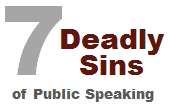Rally Your Audience with a Signature Close
 “And that’s the way it is.”
“And that’s the way it is.”
Former CBS News anchor Walter Cronkite closed every nightly broadcast with that signature phrase, a signal to his viewers of not simply the conclusion of his broadcast but the authenticity of what they had just experienced.
The familiar phrase, repeated every weeknight, threw a security blanket around his viewers. His mantra — decisive on principle and incisive on purpose — made his audience feel special, that they had been part of something tailored specifically for them.
You, too, can wrap your audience in a security blanket with a signature closing phrase at any type of recurring meetings. Read on to discover examples of mantra-like closing phrases that may stimulate your creativity in fashioning your own signature close.
Create a Mantra-like Closing Phrase
Indeed, the most effective speakers know how to define and deliver mantra-like closing phrases that infuse greater significance and ritualistic memorability to their presentations.
- Zig Ziglar, a motivational speaker, always concluded his presentations with the phrase: “I’ll see you at the top.”
- Tony Robbins, another motivational speaker, would close each segment of his seminar series with: “Live each day with passion!”
- David Gregory ends each segment of Meet the Press on NBC with “If it’s Sunday, it’s Meet the Press.”
- Paul Harvey famously ended his radio broadcast with that syncopated pause: “Paul Harvey… Goooood day.”
- And as a college public speaking instructor for the last 10 years, I always end each class with my own signature close designed to infuse more relevance into the students’ learning: “Public speaking increases your face value!”
Signature closes help your audience savor what they have just experienced. They provide the familiarity of structure even in the turbulence of changing content.
No wonder ministers end each service with an “amen.” (“So be it.”) Some church leaders even offer a Benediction, from the Latin “good saying.” As the choir concludes, the organist ends on a high note and the minister gives the Benediction: “Go now and be of good cheer…”
The most effective leaders and speakers serve their own benediction, their own brand of go forth and be of good cheer following each staff meeting or speech.
Marshaling a Magnetic Force
Sometimes that signature close becomes a rallying device, like a magnet that pulls members, customers, investors, suppliers and employees into the center of your company or organization, galvanizes diverse points of view, and sharpens the collective focus so that more consistent decisions are made over a series of meetings.
Politicians adopt a signature close to each meeting, a signature close that reinforces their mission, their vision, their sense of teamwork and their collective commitment to success. A prominent recent example is Barack Obama’s “Yes We Can.”
Project teams adopt a signature close to rekindle the creative zeal and innovative spirit to overcome challenges. e.g. “Quality is #1”
Teachers adopt a signature close to reinforce learning objectives. For example, consider a reading teacher who encouraged her students to “Book your future.”
Sometimes an entire organization can adopt a signature close to reinforce their collective commitment. Consider “The Optimist Creed” that is recited by Optimist Club members to close every meeting. Members are business leaders and professionals who wish to promote activities and programs in the community that benefit youth. The ritual closing begins when all rise and face a large banner where the words of the Optimist Creed are clearly displayed. But most recite that Optimist Creed from memory. Their closing mantra reflects who they are as an organization. Their creed is written as bold and big on their hearts as it is on the huge yellow banner in front of the room. Their voices melding in unison around a singular idea cements their relationship to each other and their collective commitment to their purpose.
Creating an Icon
Some speakers take their signature close to the next level, by creating a visual icon to represent the key theme, adding memorability and meaning with an artifact.
For example in conducting a mentoring program for a large company, I developed a recruiting speech to engage both mentors and mentees. My theme? Stay Connected. I framed mentoring as a vehicle to spark performance throughout the organization, to electrify the company, to surge energy throughout the company for greater viability.
At the end of every recruiting speech, I would hand out colorful electrical wire connectors and tell each person I handed it to “Stay Connected.” Then I turned that handout into a display for our subsequent meetings. I displayed the connectors in a large wine glass that I kept near the lectern for every subsequent collective meeting I chaired with the mentors and mentees. My mantra close then evolved into an even more memorable device to rekindle the energy and focus our attention at the next meeting.
Applying These Lessons to Your Situation
So how can you apply this signature close concept in your professional or personal life where your public speaking has to motivate more than simply educate?
Use this simple, three-step approach to determine your signature close:
- Study the mission of the organization you represent or the project team you are leading.
- Define your role/goal in a simple declarative sentence.
- Write a pithy phrase that captures the key idea in #2.
Let’s see how I applied that three step approach to teaching college students public speaking.
- First the mission of the university where I teach is “educating students to shape their lives, their professions and their societies.”
- My role as a public speaking instructor is to help students shape their communications skills so that they can leverage their knowledge and become even more valuable and valued in society.
- Then I linked the concept of value with the skill of speaking and my signature close becomes: “Public Speaking Increases Your Face Value.”
And that’s the way it is.
Please share this...
This is one of many public speaking articles featured on Six Minutes.
Subscribe to Six Minutes for free to receive future articles.
Subscribe - It's Free!
| Subscribe via Email | |
| Subscribe via RSS | |
| Follow Us |
|
Similar Articles You May Like...
Find More Articles Tagged:
 4 Comments
4 Comments
 Recent Tweets
Recent Tweets
RT @6minutes Rally Your Audience with a Signature Close http://bit.ly/92ar1i
— Fred E. Miller Apr 13th, 2010
Rally Your Audience with a Signature Close http://bit.ly/9cPjxx *** wonderful pointers from @6minutes
— Lizette Pirtle Apr 14th, 2010
Agree or disagree: Rally your audience with a signature close? http://bit.ly/c6qR4E
— Barry Hurd Apr 15th, 2010
Rally your audience with a signature close @ http://ow.ly/1Bu2m
— stephanie scotti Apr 22nd, 2010
Rally Your Audience with a Signature Close http://bit.ly/92ar1i
— sandi smith May 18th, 2010
Rally Your Audience with a Signature Close – http://bit.ly/cM7yAR
— Lee Johnson May 24th, 2010
SPEAKERS: "Rally Your Audience With A Signature Close!" –> http://ht.ly/1SrZ0
— Legacy Architect Jun 1st, 2010
RT @ThomScott: SPEAKERS: "Rally Your Audience With A Signature Close!" –> http://ht.ly/1SrZ0
— Jay Handler Jun 1st, 2010
Rally Your Audience with a Signature Close http://bit.ly/92ar1i
— Cesar Gamez Jun 14th, 2010
Rally Your Audience with a Signature Close https://t.co/N5idZF5alO by @6minutes
— @Lizzc Feb 5th, 2019
















This is a clever idea, but it’s self-referential rather than focused on the audience. A better way to end a speech is with a call to action (or an actual action) for the audience. That puts the focus where it belongs: on them.
What a great article about closing a speech and action steps. I think I am going to think of a catchy saying to say every time I finish a speech. I think It would help me with branding myself.
Peter: Great points about branding your close here.
It brings to mind all the Zig Ziglar speeches I attended and his signature close.
Personally, and I’m glad you reminded me, I’m going to revive the signature close I used to use on a regular basis. It is:
“I’m going to close with a Challenge and a Prediction. My Challenge is this: . . . “Do that, and my Prediction is . . .”
Thanks for the Post!
Fred E. Miller
Peter,
A nice article and touched on some areas that I am very passionate about. The tagline can be used to brand you and your speech but – as Nick mentioned – should also be a way to connect with the audience. Thinking symbolically is an excellent exercise for the speaker to distill their message into a more visual form so that it is easier to remember and importantly, easier for the audience to understand.
Warwick John Fahy
Author, The One Minute Presenter
Related article:
Using taglines and word pictures
http://www.oneminutepresenter.com/2010/04/product-launch-like-an-executive-memorable-product-launches-part-2/